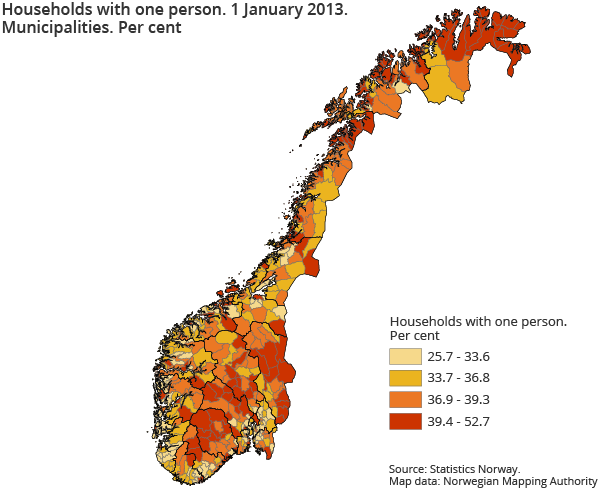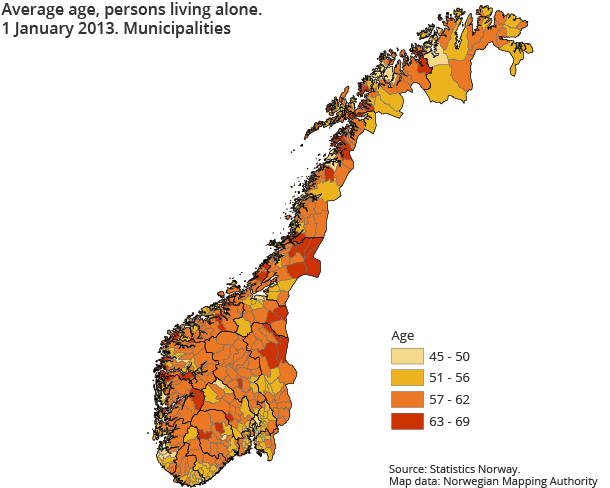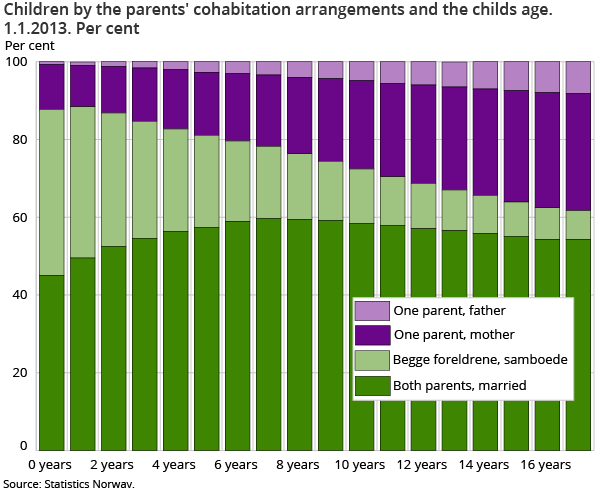Content
Published:
This is an archived release.
32 700 more households
The number of households increased by 32 700 in 2012. At present there are 2 259 000 private households in Norway. Most people live in a household with 2 persons. It is also quite common to live alone.
| 2012 | 2013 | Change in per cent | |
|---|---|---|---|
| 2012 - 2013 | |||
| Households | 2 226 046 | 2 258 794 | 1.5 |
| Persons in private households | 4 933 388 | 4 990 842 | 1.2 |
| Number of persons per private househol | 2.2 | 2.2 | -0.3 |
| Population by type of household | |||
| One-family households, total. | 4 656 280 | 4 710 233 | 1.2 |
| Two or more-family households, total. | 277 108 | 280 609 | 1.3 |
| Other housesholds | 52 482 | 60 433 | 15.1 |
The rise in the number of households is mainly due to an increase of 65 400 inhabitants in Norway in the same period. The average household size dropped slightly from 2.22 to 2.21 persons per household. Most people, one in four, live in a household with 2 persons. Almost as many, 23 per cent, live in a household with 4 persons.
Many people live alone
It is also quite common to live alone, with 18 per cent of the population doing so. The proportion of people living alone has increased gradually over a very long period of time. The greatest increase was between 1960 and 1990. In 1920, only two per cent lived alone. In 1960, the number had increased to four per cent and by 1990 14 per cent of the population lived alone. There are now approximately 896 000 households with only one person in Norway. This means that 18 per cent of persons living in private households live alone and that 40 per cent of households consist of only one person; the same as in recent years.
Oslo has the highest proportion of one-person households, with slightly over 52 per cent. There is also only one person in almost half the households in a dozen municipalities in the three northernmost counties. Most of these municipalities are in the county of Finnmark. High up on the list are also the cities of Bergen and Trondheim, with 45 per cent one-person households. At the bottom of the list there are 25 municipalities with a share of less than 30 per cent one-person households. Municipalities with the lowest shares of one-person households are found mainly in the areas surrounding the major cities of Bergen, Oslo, Trondheim and Stavanger. In these municipalities between 25 and 30 per cent of households consist of one person.
Young people live alone in the cities
The average age of persons living alone in Norway is 52 years; 58 years for women and 46.5 years for men. The youngest people living alone are found in Oslo, Trondheim, Tromsø, Ås, Stavanger and Bergen. The average age for both sexes in these municipalities is between 45 and 48 years. The highest average ages are found in the more peripheral municipalities, with Røyrvik and Fedje on top. In these municipalities the average age of those living alone is 69 and 68 respectively.
Three out of four children live with both parents
At the turn of the year, 1 109 000 children in Norway below the age of 18 were living at home with their parents. Seventy-five per cent of these children lived with both parents. This proportion varies with age and decreases gradually from 88 per cent for children at birth to 62 per cent for children aged 17. About three-quarters of those living with both parents live with married parents. This proportion also varies with the age of the children. Barely half live with married parents in their first year of life. This proportion increases to 88 per cent for the 17-year-olds who at that age are still living with both parents.
Four out of five children live with siblings
Four out of five children are living with siblings. Of these, 84 per cent are living with biological siblings only, while nine per cent are living with half siblings only. The remaining seven per cent are living with various combinations of biological siblings, half siblings, and stepbrothers/-sisters.
Contact
-
Statistics Norway's Information Centre
E-mail: informasjon@ssb.no
tel.: (+47) 21 09 46 42
-
Espen Andersen
E-mail: espen.andersen@ssb.no
tel.: (+47) 92 61 00 46
-
Ane Margrete Tømmerås
E-mail: ane.tommeras@ssb.no
tel.: (+47) 91 99 29 62
-
Oppdrag befolkningsstatistikk
E-mail: befolkning@ssb.no



